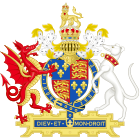This article needs additional citations for verification. Please help improve this article by adding citations to reliable sources. Unsourced material may be challenged and removed.Find sources: "Chester and Cheshire (Constituencies) Act 1542" – news · newspapers · books · scholar · JSTOR (September 2008) (Learn how and when to remove this template message)
| Act of Parliament | |
 | |
| Long title | An Act for Knights and Burgesses to have Places in the Parliament for the County Palatine and City of Chester |
|---|---|
| Citation | 34 & 35 Hen. 8. c. 13 |
| Territorial extent | Kingdom of England |
| Dates | |
| Royal assent | 12 May 1543 |
| Commencement | 1 October 1543 |
| Repealed | 30 July 1948 |
| Other legislation | |
| Repealed by | Representation of the People Act 1948 |
Status: Repealed | |
| Text of statute as originally enacted | |
The Chester and Cheshire (Constituencies) Act 1542 (34 & 35 Hen. 8. c. 13) is the Act of Parliament allowing Cheshire to be represented in the Parliament of England. The county palatine of Chester, ruled by the earls of Chester, was established by William the Conqueror. Cheshire had its own parliament, consisting of barons of the county, and was not represented in the Parliament of England. After the passing of the act Cheshire retained some of its special privileges until 1830. The earldom of Chester is traditionally vested in the sovereign's eldest son upon his crowning as Prince of Wales.
The Act was repealed by section 80 of, and Schedule 13 to, the Representation of the People Act 1948 (c.65).